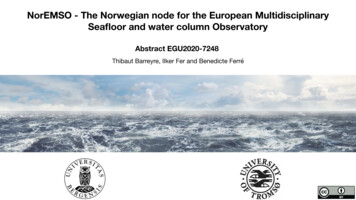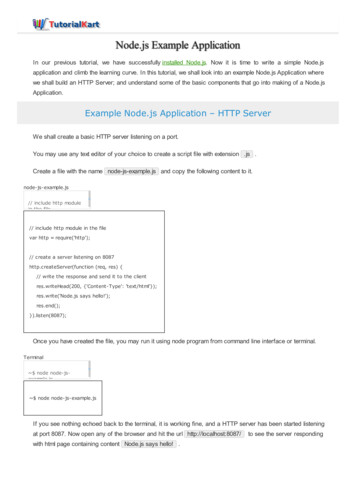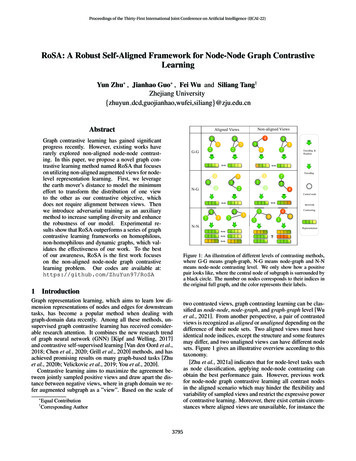
Transcription
NorEMSO - The Norwegian node for the European MultidisciplinarySeafloor and water column ObservatoryAbstract EGU2020-7248Thibaut Barreyre, Ilker Fer and Benedicte Ferré
EMSO PP - European Multidisciplinary Seafloor ObservatoryEuropean network of fixed-point deep-sea observatories addressed to Marine Ecosystems,Climate Change and Geo-hazards long-term monitoring and inter-disciplinary studies
EMSO ERIC – Regional facilitiesGeosciencesBiogeochemistrySeismicityGas hydrate stabilitySeabed fluid flowSubmarine landslidesSubmarine volcanismGeo hazard early warningOcean acidification & solubility pumpBiological pumpHypoxiaDeep-ocean biogeochemical fluxesContinental shelf pumpMarine ecologyClimate forcing of ecosystemsMolecules to microbesFisheriesMarine noiseDeep biosphereChemosynthetic ecologyPhysical oceanographyOcean warmingDeep-ocean circulationBenthic and water column interactionsMarine forecastinghttp://emso.eu
The Norwegian node for the EuropeanMultidisciplinary Seafloor and water columnObservatory 60 millions nok from INFRASTRUKTUR call Establish and expand a unified national monitoring ofwater bodies Contributeto the European deep-sea observationnetwork Monitorsea circulation and acidification, physicalprocesses in the water column from the surface to thegreat depths, as well as the ecosystem and watermasses at the newly discovered hydrothermal site onthe Mohn Ridge
The Norwegian node for the EuropeanMultidisciplinary Seafloor and water columnObservatoryThe network of NorEMSO in the Nordic Seas hasthree main components:Glider sections (red): (1) Svinøy, (2) Gimsøyand (3) South Cape West, (4) Fram Strait, (5)Greenland Sea and (6) Iceland SeaMoored observation systems (circles): Svinøy,Station M, South Cape, and Fram StraitThe EMSO Mohn observatory over the MohnRidge (triangle)Integration across Nordic SeasExchanges, transformations
Ocean Gliders sustainable, fine resolution observations even in severeweather conditions upper 1000 m, 4-6 h cycle,20-25 km/day horizontal speed, 4-12 mon. deployments Impact ocean modeling and forecastsNorwegian National Facility for Ocean Gliders http://norgliders.gfi.uib.no As of today, 5 Kongsberg Seagliders, 2 TDW Slocums Piloting tool & Glider Portal developed at GFI A Glider Lab and 24/7 operation team of pilots Near real-time data delivery NorEMSO will expand on the glider facility by 5 new deep gliders a national team of pilots, by training and integrating technicians from partner institutions
MooringsSt. MContinuation of long-term observationsStation M (only subsurface); Svinøy; Fram StraitCourtesy of Norwegian Polar Institute
EMSO - Mohn At a hydrothermal vent side on Mohn Ridge, co-located with aglider section A fixed-point seabed-based compact and wireless observatorywith a multidisciplinary approach – from geophysics and physicaloceanography to ecology and microbiology Sensors include an Acoustic Doppler Current Profiler, a pressuregauge, a temperature probe, a conductivity sensor, a turbiditymeter, an optode, and a hydrophone Acoustic modems enable wireless communications Data Processing Unit for on board data reduction
Data management Open Research Data Pilot ; FAIR data management principles free and open access to all metadata and data (NRT and delayed mode)CC BY 4.0 and NLOD (Norsk lisens for offentlige data) Data will be delivered and made available through the Norwegian Marine DataCentre (NMDC) and international portals such as CMEMS,EMODnet, Coriolis, SeaDataNet/SeaDataCloud, SEANOE The data management of NorEMSO will function as aregional node and use existing competence and datainfrastructure at UiB (Bjerknes Climate Data Centre) andarchives of the Norwegian Marine data Centre hosted bythe Institute of Marine Research
The Norwegian node for the European Multidisciplinary Seafloor and water column Observatory 60 millions nok from INFRASTRUKTUR call Establish and expand a unified national monitoring of water bodies Contribute to the European deep-sea observation network Monitor sea circulation and acidification, physical processes in the water column from the surface to the










